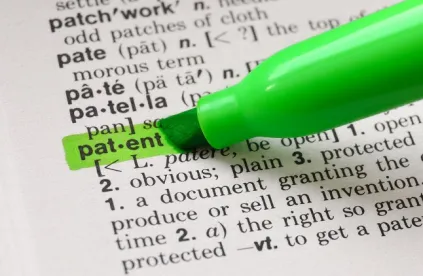Holding
In Chudik v. Hirshfeld, No. 2020-1833 (Fed. Cir. Feb. 8, 2021), a panel of the U.S. Court of Appeals for the Federal Circuit (TARANTO, Bryson, and Hughes) affirmed a district court’s determination that patentee, Chudik, was not entitled to additional patent term extension under 35 U.S.C. § 154(b)(1)(C)(iii). The Federal Circuit, upholding the PTO’s interpretation of the statute, ruled that the (C)(iii) provision applies only where the Board or other appellate court (i) has jurisdiction over the appeal and (ii) reverses an adverse determination of patentability.
Applicable Statutes and Regulations
35 U.S.C. §154(b)(1) sets forth the PTO’s framework for patent term adjustment (PTA). Two of the adjustment provisions, known as B-delay and C-delay, were relevant to the court’s decision:
B-Delay: awards 1 day of patent term extension for each day beyond 3 years from filing until the patent issues. 35 U.S.C. §154(b)(1)(B).
C-Delay: awards adjustments for delays due to interferences, secrecy orders, and appeals, with an award of 1 day for each day of the pendency of the proceeding, order, or review. 35 U.S.C. §154(b)(1)(C).
These adjustments are not without limitation—35 U.S.C. § 154(b)(1)(B)(i)) precludes adjustments under B-delay for “any time” consumed by applicant’s request for continued examination.
Furthermore, 37 C.F.R. §§ 1.702(e) and 1.703(b)(4) explain that C-Delay adjustments will not accrue until the Board takes jurisdiction of the appeal (when reply brief is filed or time to file has expired). 37 C.F.R. §1.702(e) also provides that:
[T]he term of an original patent shall be adjusted if the issuance of the patent was delayed due to review by the Patent Trial and Appeal Board under 35 U.S.C. 134 or by a Federal court under 35 U.S.C. 141 or 145, if the patent was issued under a decision in the review reversing an adverse determination of patentability.
Background
Chudik filed a patent application on Sept. 29, 2006. Although twice (and finally) rejected in Jan. 2011, Chudik requested continued examination under 35 U.S.C. § 132(b) instead of filing an appeal with the Patent Trial and Appeal Board (Board). The claims finally issued 11 years later on May 15, 2018, after four notices of appeal. Critically, the examiner reopened prosecution after each notice of appeal, and the application never proceeded to the Board for review.
Following issuance by the Examiner, the PTO awarded Chudik 1,967 days of patent term adjustment. Patentee filed two petitions for an additional 754 and 655 days, respectively, arguing that further adjustment was warranted for the delays incurred pending appeals under 35 U.S.C. § 154(b)(1)(C)(iii). Although patentee was ultimately awarded 2,066 days of adjustment under B-delay, the PTO denied both petitions, reasoning that patentee was not entitled to additional PTA under C-delay because (1) the Board’s jurisdiction over the appeal never attached, and (2) the Board never reversed the examiner’s decision.
District Court
Chudik challenged the PTO’s decision in the District Court for the Eastern District of Virginia, which upheld the PTO’s PTA calculation. Here, Chudik argued that an adjustment was warranted under C-delay because (1) provision C applies to delays incurred during the entire appeals process, starting with the filing of a Notice of Appeal, and (2) the examiner’s decision to re-open prosecution and subsequently allow the application constituted a “review reversing an adverse determination of patentability.” The Court disagreed. Id. at *9. Although the district court acknowledged that Chudik’s interpretation was reasonable, it determined that the PTO’s interpretation was also reasonable and thus entitled to Chevron deference. Id. (citing the USPTO’s interpretation in its Federal Register Notices: 65 Fed. Reg. 56,366, 56,369–70 (Sept. 18, 2000) and 77 Fed. Reg. 49,354, 49,357, Resp. to Cmt. 11 (Aug. 16, 2012)).
Federal Circuit
The Federal Circuit affirmed the district court, finding that C-delay was inappropriate under either the Chevron or Skidmore deference frameworks. The “best” and “natural” reading of the statute were both consistent with the PTO’s interpretation of the statute: C-delay applies where a patent issues “under a Board decision that reversed the examiner’s unpatentability ruling or under a court decision that reversed a Board unpatentability ruling.” Id. at *11. An interpretation that the provision also covers an examiner’s decision to reopen prosecution or withdraw a rejection is strained, “if not linguistically impossible.” Id. at *12.
The Federal Circuit further indicated that Chudik’s decision to pursue a request for continued examination instead of an appeal at the earliest opportunity, effectively deprived him of nearly two years of PTA. The decision “illustrates what applicants should understand when deciding whether to request a continued examination rather than take an immediate appeal. The potential benefit of immediate re-engagement with the examiner through such continued examination comes with a potential cost.” Id. at *15.
Take-Away
This case is a cautionary tale to applicants debating whether to file an appeal or request continued examination before the examiner. Each case, of course, depends on its own facts and circumstances. Although there are various benefits to continued examination, these benefits must be weighed during prosecution against the risk of losing potential patent term adjustment, especially where the need for an appeal becomes increasingly apparent during prosecution. Ultimately, in balancing the pros and cons, applicants must remember that (1) C-delay term adjustment cannot apply unless the Board or reviewing court assumes jurisdiction of an appeal and reverses the adverse patentability decision of at least one claim under review, and (2) B-delay term adjustment does not apply to delays attributable to patentee’s decision to request continued examination.



 />i
/>i

